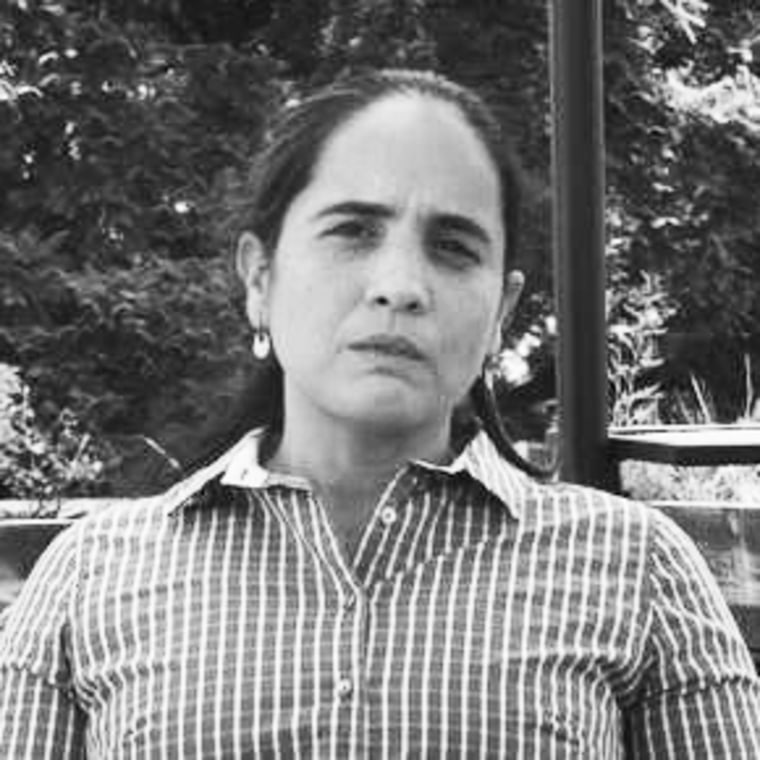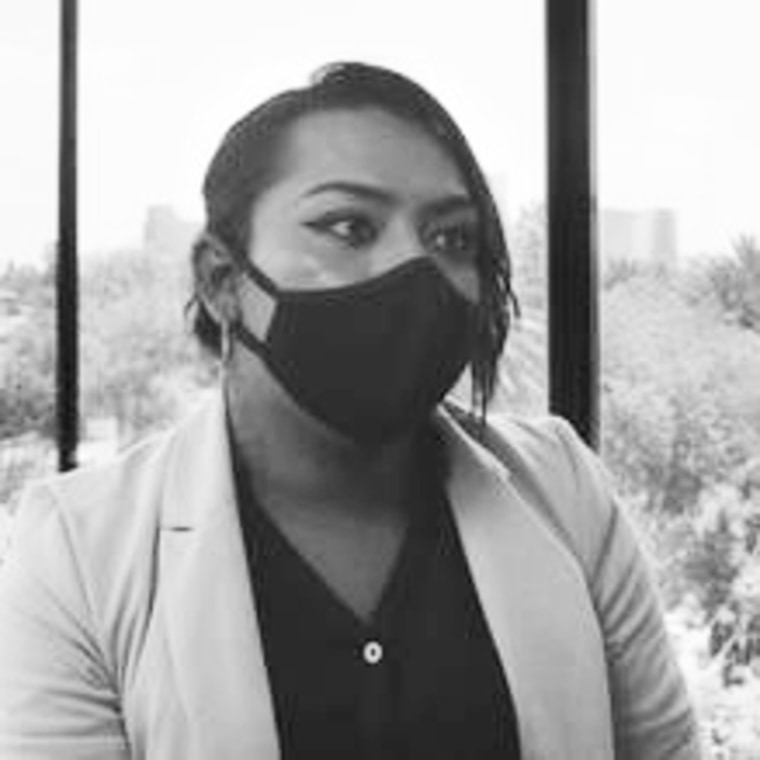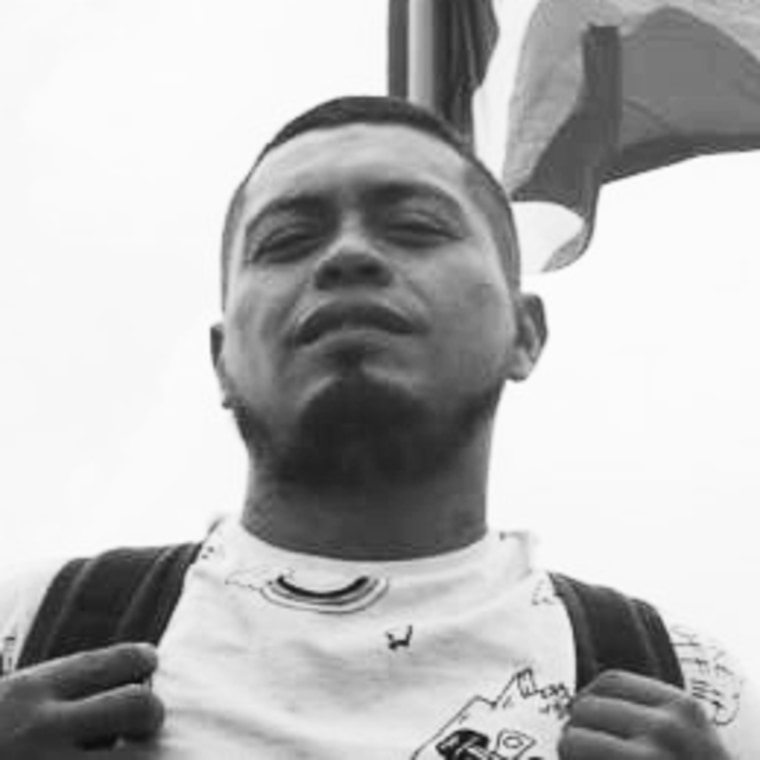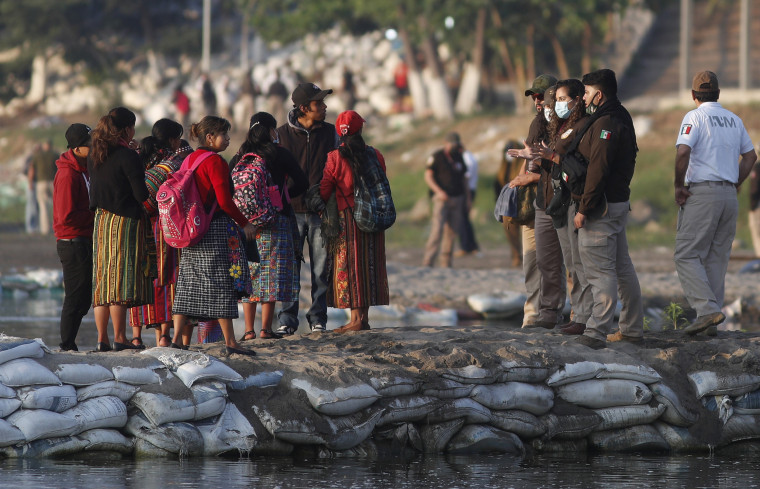MEXICO CITY — Marian Pérez Guerra, 39, knew when it was time to leave her home country of Nicaragua.
"They started shooting at our house. That's where we knew we had to leave," she said, recounting the threats she constantly received following her participation in demonstrations against the government of President Daniel Ortega.
"They said they were going to kidnap me, in some cases they told me they were going to rape me, to make me disappear," said Pérez Guerra, who left in September 2018 and is now living in Mexico City.
In recent years, Mexico has ceased to be a transitory country for people heading to the United States, increasingly becoming the final destination of an important migratory flow. Between 2014 and 2019, the number of asylum applications registered in the country increased from 2,137 to 70,418 — an increase of more than 3,000 percent, according to the Mexican Commission for Refugee Assistance, or COMAR.
"You arrive very beaten, and you have to learn to transform the pain," Pérez Guerra said about her new life. "That is why I will always be grateful to Mexico for giving me refuge."

Pérez Guerra is part of a massive global tide: In 2020 there were 82.4 million registered refugees and internally displaced persons, according to the most recent report by the United Nations High Commissioner for Refugees.
This is a record figure, more than double the almost 40 million of a decade ago. It is comparable to Germany’s entire population leaving the country.
In 2013, Mexico registered only 1,296 applications for asylum. Four years later, the number was 14,619, and by 2019, the government had received over 70,000 requests. The total figure for 2021 is projected to be between 90,000 and 100,000 asylum applications.
Due to its size and economic opportunities, Mexico has been able to handle the migratory flow driven by the successive crises in Central American countries, according to Andrés Ramírez Silva, who heads COMAR.
"The country has the capacity to receive them. However, that poses a significant challenge for us because we are prepared to serve a certain number of people, and, suddenly, it rises very quickly until it becomes something emergency," said Ramírez, who worked for more than two decades at UNHCR and is an expert on migration policies in the region. "That's why there's not enough in the budget or in operational capacity. It's a phenomenon that is occurring in many countries, not only in Mexico."

As part of Mexico's asylum process, a person must remain in the state where the application is made during the time the process lasts, which, in normal times, should range between 45 and 90 business days. However, due to the Covid-19 pandemic, COMAR announced in March 2020 that it was suspending the deadlines for these processes. This has generated multiple complaints from migrants who are trapped in places where they cannot work, in large part because they lack adequate documentation.
"The vast majority of people enter from the south, but the state that has the highest percentage of the border is Chiapas, specifically the Tapachula part. They apply there and, by law, they have to stay there," Ramírez said. "That is the paradox because a bottleneck is generated, and in Chiapas, which is one of the poorest states, 71 percent of the applicants remain there.”
This has been the experience of Katsury, a 24-year-old trans woman who is only being identified by her first name for her protection. She fled Guatemala after she started getting threats for accusing her partner of physical and psychological abuse, leading to his imprisonment. She said the beatings and abuse affected her mental health and she attempted suicide twice. After the threats, she fled and requested protection at the Mexican border in January.

"When I arrived, I was desperate. I told the military that I needed a shelter and they let me pass, but you have to understand that COMAR is overwhelmed in Chiapas. They don't have the capacity," she said.
"When they told me that they could only give me a regional permit, that I had to stay there, I had to keep running. Nobody understands that there they can kill me because that is next to Guatemala and anyone can pass armed," Katsury said fearfully.
With the help of UNHCR, Katsury began her process in Mexico City but has yet to receive a response due to multiple bureaucratic delays. She is still experiencing depression, but she said she is happy to be able to work as a hairstylist, her favorite trade, and hopes to stay in the country.
"I feel happy because here my rights have been recognized. That does not happen in Guatemala," Katsury said. "If we had an adequate government that helps the population and that the economy is fine, without violence, I think we would not migrate to another country."
The lag — and the horror
In Chiapas, local media and human rights organizations have denounced the limitations in processing the intense migratory flow that has reached 2,000 people a day — though only between 600 and 700 foreigners can be attended to on a daily basis.
According to an investigation by El Colegio de la Frontera Norte published in May, there is a long lag to recognize refugee status.
"For 2019, the number of applications was 70,609 and the number of cases that were resolved was 14,234, which is only 20 percent, which shows that there is a fairly high number of pending cases," the researchers wrote.
Based on COMAR data, experts point out that from Jan. 1, 2018, to Oct. 25, 2019, there were 90,397 applications for refugee status, and 70.6 percent (63,860) were awaiting resolution. Of that figure, "6,230 people had been waiting for more than a year," the document stated.
Another factor that can complicate the process is if people leave the Mexican region where they made the asylum request. COMAR considers the process abandoned, so the refugees have to restart all the paperwork, in most cases.
"There are people who have a year or more waiting for a resolution in those places where there are no job opportunities, but there is a lot of discrimination," Alejandra Macías, director of the organization, Asylum Access Mexico, said. "In addition, the persecutions reach there because it is the border. That is why people leave and lose their processes, becoming more vulnerable."
Since January 2020, Carlos Monge has not had any answers from the Mexican government. He explained that he never wanted to leave Chalchuapa, his town in El Salvador, where he was dedicated to agriculture and loved to visit the ruins of Tazumal, an imposing Mayan settlement of pyramids and sophisticated stone temples that are surrounded by deep green.
"I am proud to be Indigenous, that is why I tattooed a jaguar that is sacred to us. But I couldn't handle the criminals who always beat me. I had no life," he said with dismay.
Monge crossed the Mexican border in January of last year and walked to Acayucán, Veracruz, where he started his application and planned to stay in an immigration station until it was finished.
But Covid-19 disrupted his plans. Weeks later, Mexican authorities transferred him, along with dozens of other migrants, to the border with Guatemala.
"Nobody told us anything, pure lies. The bad thing is that they can kill me. I can't go back," Monge said with concern.
He walked through various states to Mexico City, where he arrived with injured knees. Because he was transferred out of Veracruz where he initially filed for asylum, his application was stopped.
"It's crazy. The same migration people arbitrarily moved us. The only thing I want is to live here, work and be free, but they won't let me," he said, sobbing.
Monge lasted almost seven months in the Mexican capital, sleeping in empty spots, always on the ground and in the open. He fell ill with chronic asthma, and he later got pneumonia. With the help of Asylum Access, he started the process again in Mexico City but had to interrupt it because he never got a job amid the Covid-19 fallout.
He's now in Tijuana, working in security for a pharmacy, adding that the warmer weather helps improve his breathing.
"Unfortunately, I lost the whole process again, and there I am fighting with my lawyer to see if we can get COMAR to answer us. If I had wanted to go, there is the wall," he said in a video call, while pointing to the U.S. border fence. "But I want to be Mexican," he said firmly.
Delays, unemployment, depression and stress from the uncertainty of not having a legal stay in the country are not the greatest dangers that refugees face. There are multiple complaints of people kidnapped by criminal organizations, enslaved by the cartels and murdered while they await the resolution of their procedures.
This happened to Cristian San Martín Estrada, a Cuban asylum-seeker who was killed in May in Ciudad Juárez when he was only a few days away from being allowed to enter the U.S., where he was seeking asylum.
Doctors Without Borders, a nongovernmental organization dedicated to health care, created a comprehensive care center in 2018 focused on treating refugees who have experienced episodes of extreme violence during their migration route.
"The abuses we deal with range from blunt beatings, mutilations, kidnappings, extortion, death threats, people who witness torture, forced to carry out actions against their will and many are victims of sexual abuse," said Jorge Diego López Núñez, a psychologist with the organization. "It is violence characterized by cruelty, which is carried out in order to cause pain and suffering to the victim."
Pedro, a 44-year-old Guatemalan asylum-seeker, is one of them. Sitting in the courtyard of the center, under a tree, he tries to control his right leg, which is shaking incessantly.
'God willing, my future is here'
"I don't know why that had to happen to me," Pedro, who is only being identified by his first name for his protection, said between sobs.
He arrived in Mexico after being persecuted by gangs that extorted him to the point where he had to abandon his family's onion crops. In January, he boarded a freight train that took him to Veracruz, where he was repeatedly raped by men looking for cell phones and money.
"I don't know why they did that to me if I am a man, why didn't they kill me," he said tearfully.
He said he later suffered abuses and beatings at an immigration station in Saltillo, in the state of Coahuila. When he was finally released, he filed a complaint, and he is in the middle of a legal process.
He still does not have a resolution on his asylum case. When he talks about soccer, he smiles a little and says he liked to play as a forward and dreams of scoring goals again.
"I still can't; I have to have surgery. But I don't lose hope," he said, looking at his hands.
When asked if he wants to continue in Mexico, after all he has lived through, he answered without hesitation: "Of course I want to stay. Otherwise, why did I suffer all this? I think that, God willing, my future will be here."
A hope for Venezuelans
According to the UNHCR, 68 percent of the world's refugees and displaced people come from five countries: Syria, Venezuela, Afghanistan, South Sudan and Burma. The case of Venezuela stands out: Without suffering an armed conflict, 4 million people have left due to the political and economic crisis.
Ángel Sucre is one of those millions. At 28, the former engineering student and spokesperson for the opposition organization Jóvenes Venezolanos has traveled through more than seven countries in his quest to escape the persecution of the Nicolás Maduro regime, which he said imprisoned and tortured him for more than a year. His case was denounced by various human rights organizations such as Penal Forum in Venezuela, which highlighted the "procedural uncertainty" and physical abuse he suffered.

"The worst thing was when they rolled you up on a mat and pummeled you with baseball bats. Do you know why they did that? Because it doesn't leave scars, but it breaks you inside," he said, walking through the Mexican capital.
Sucre went to Peru, where he was just getting used to freedom and began to dream of having his own place that would merge the gastronomy of Peru and Venezuela. Then Covid-19 arrived, along with more xenophobia against migrants.
"When they made a graffiti near my house that said, 'Damn Venezuelans,' I understood that I had to go. I left in January 2021 and here I am," he said.
He's traveled hundreds of miles by bus, cars, motorcycles and boats to cross Ecuador, Colombia and the dangerous Darién jungle region, where "it is almost impossible to cross without something serious happening to you."
After escaping from a refugee camp in Panama, fleeing Central American gangs and getting on the Beast — the famous Mexican freight train — Sucre said he will try to reach the United States to fulfill his dream of "studying and being a better person."
But Sucre did not rule out staying in Mexico if it doesn't work out in the U.S.
"It is an incredible country. I feel happy here," he said with emotion. "Everywhere there are problems, but Mexicans are enterprising people. The truth is that they inspire you to stay."
An earlier version of this story was first published in Noticias Telemundo.
Follow NBC Latino on Facebook, Twitter and Instagram.
